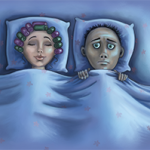She also incorporates laughter yoga and even gratitude exercises into her treatment. Use of CBT also tends to help clients gradually reduce their use of sleeping pills, she says.
In addition to treatments specific for common sleep problems, both sleep specialists and rheumatologists can cover some basic sleep solutions with fibromyalgia patients, such as:
- Keeping track of sleep habits and when sleep issues occur;
- Exercising regularly;
- Practicing good sleep hygiene with a regular and consistent sleep schedule, and using the bed only for sleeping;
- Performing meditation and relaxation techniques;
- Cutting back or stopping the use of artificial light and electronic devices at night;
- Trying melatonin, a natural sleep aid; and
- Focusing on the positive.
“When we are depressed, anxious or sleep-deprived and in chronic pain, we see the world with dark, gloomy glasses and tend to forget things that are going right,” Ms. Kormeili says. That’s why she’s found that such activities as gratitude awareness work especially well in fibromyalgia patients.
What About Sleeping Pills?
Experts from both rheumatology and sleep medicine tend to eschew sleeping pills for sleep treatment. “Brain waves on electroencephalography start to display unusual signals with many sleeping pills. It is increasingly becoming evident there are increased accidents and early dementia with long-term use of sleep medications,” Dr. Yeam says.1,2
He also says fibromyalgia patients usually have an increased exposure to physicians and medications compared with the general population, which can lead to an increased focus on trying to improve sleep through medications and gadgets. “All these can result in habits and preconceived ideas that may not be conducive to a healthy sleep routine,” he says.
“All sleeping pills are habit-forming and produce rebound insomnia after prolonged use. I believe it is best to avoid them or use them on a short-term basis,” says Anca D. Askanase, MD, MPH, the clinical director and founder of the Columbia University Lupus Center in New York City, and associate professor of medicine in the Division of Rheumatology at the Columbia University Medical Center, New York.
In addition to the aforementioned treatments, it’s important to give patients a better understanding of what a good night’s sleep is, Dr. Yeam says. “One of the myths I’d like to erase is that there is perfect sleep,” he says. “Perfect sleep, as most people define it, does not exist. Sleep is an active state with various stages. The brain does not slow down, nor does it shut off. Many parts of the brain are actively functioning.”

